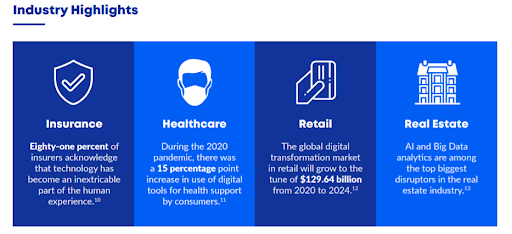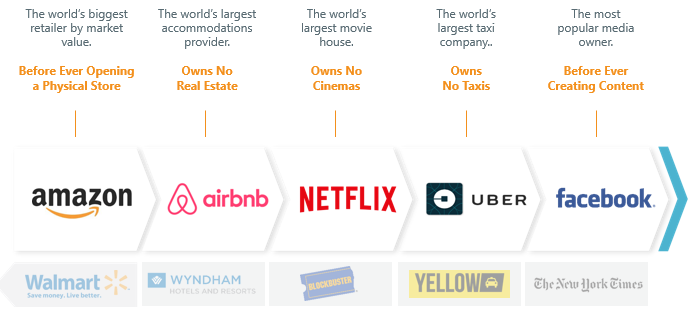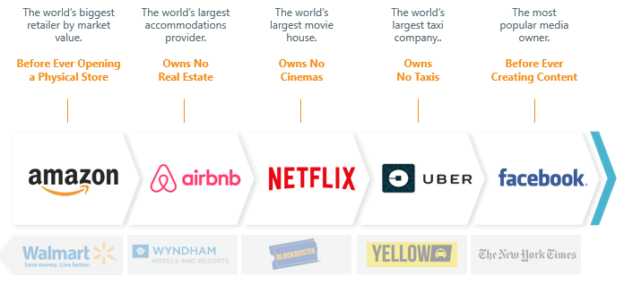Digital transformation has become a buzzword in recent years, but what does it really mean? Simply put, it refers to the integration of digital technologies into all aspects of a business, fundamentally changing how organizations operate and deliver value to customers. From traditional brick-and-mortar retailers embracing e-commerce to banks adopting mobile banking apps, the potential for digital transformation is vast. In this article, we will explore some of the biggest examples of digital transformation across various industries, showcasing how businesses are adapting and thriving in the digital age.
1. Retail Industry
The retail industry has embraced digital transformation in various ways, with e-commerce platforms leading the charge. These platforms have revolutionized the way consumers shop, allowing them to browse and purchase products from the comfort of their homes. Online retailers like Amazon and Alibaba have become giants in the retail industry, reshaping the landscape and challenging traditional brick-and-mortar stores.
In addition to e-commerce, mobile payments have gained significant traction in the retail sector. With the widespread adoption of smartphones, consumers can now make payments using digital wallets or mobile payment apps. This convenient and secure method of payment has transformed the checkout process, making transactions quick and seamless.
Furthermore, self-checkout systems have become increasingly prevalent in retail stores. These systems enable customers to scan and pay for their items themselves, eliminating the need for traditional manned checkout counters. Self-checkout not only reduces costs for retailers but also provides customers with a faster and more efficient checkout experience.
Another exciting development in the retail industry is the use of augmented reality (AR) in shopping experiences. AR technology allows customers to visualize products in a virtual environment, helping them make more informed purchase decisions. For example, customers can use AR applications to see how furniture would look in their homes before making a purchase. This immersive and interactive shopping experience enhances customer engagement and satisfaction.
2. Financial Services
Digital transformation has significantly impacted the financial services sector, bringing about various innovations that have revolutionized the way we manage our money. Online banking has become increasingly popular, providing customers with convenient access to their accounts and enabling them to perform transactions, check balances, and pay bills from anywhere at any time.
Digital wallets have also transformed the way we make payments. With digital wallet applications like Apple Pay and Google Pay, users can store their credit and debit card information on their smartphones and make seamless contactless payments with a simple tap. This technology has made payments faster, more secure, and less reliant on physical cards.
Robo-advisors are another significant development in the financial services industry. These automated investment platforms use algorithms and machine learning to provide personalized investment advice and manage portfolios. Robo-advisors have made investing more accessible to the masses and have disrupted the traditional wealth management industry.
Blockchain technology has the potential to redefine financial services by creating decentralized and secure systems for transactions and record-keeping. Blockchain, the technology behind cryptocurrencies like Bitcoin, enables transparent and tamper-proof transactions, eliminating the need for intermediaries and reducing transaction costs. Financial institutions are exploring ways to harness the power of blockchain to streamline processes and enhance security.

This image is property of assets-global.website-files.com.
3. Healthcare
Digital transformation has had a profound impact on the healthcare industry, improving patient care, streamlining processes, and enabling more accurate diagnoses. Telemedicine has emerged as a game-changer, allowing patients to consult with healthcare professionals remotely through video calls or online platforms. This technology eliminates the need for in-person visits, particularly for non-emergency cases, and provides greater accessibility to healthcare services, especially in rural or underserved areas.
Electronic health records (EHRs) have also transformed the way healthcare providers store and access patient information. EHRs allow for comprehensive and real-time digital records, providing healthcare professionals with seamless access to patient histories, test results, and treatment plans. This improves patient care coordination, reduces errors, and enhances overall efficiency in healthcare delivery.
Artificial intelligence (AI) has made significant strides in diagnostics, aiding healthcare professionals in making accurate and timely diagnoses. AI algorithms can analyze vast amounts of medical data and identify patterns or anomalies that may go unnoticed by human practitioners. This technology has the potential to revolutionize disease detection and improve patient outcomes.
Data-driven healthcare management has also emerged as a key aspect of digital transformation in the healthcare industry. By leveraging data analytics and machine learning algorithms, healthcare organizations can gain insights into patient populations, identify areas for improvement, and implement targeted interventions. Data-driven management ensures more efficient resource allocation, better patient outcomes, and cost savings.
4. Transportation
The transportation industry has witnessed significant digital transformation, with various technological advancements shaping the way we travel and transport goods. Ride-sharing platforms like Uber and Lyft have revolutionized urban transportation, providing convenient, affordable, and on-demand transportation services. These platforms have disrupted the traditional taxi industry and have transformed the way people move around cities.
Electric and autonomous vehicles are poised to transform the transportation industry further. Electric vehicles offer a more environmentally friendly alternative to traditional gasoline-powered cars, reducing carbon emissions and promoting sustainability. Meanwhile, autonomous vehicles have the potential to enhance safety and efficiency on the roads, with the promise of reducing accidents caused by human error. The deployment of self-driving cars in the near future could fundamentally change the way we commute.
Intelligent transportation systems (ITS) have also become a prominent aspect of digital transformation in the transportation sector. These systems use advanced technologies, such as sensors and data analytics, to monitor and manage traffic flows, optimize signal timings, and improve overall transportation efficiency. ITS can help reduce congestion, enhance safety, and improve the overall travel experience.
Connected logistics, enabled by digital transformation, has streamlined the movement of goods and improved supply chain management. With technologies like the Internet of Things (IoT) and data analytics, companies can track shipments, manage inventory, and optimize routes in real-time. This visibility and efficiency in logistics ensure timely deliveries, reduce costs, and enhance customer satisfaction.

This image is property of www.revechat.com.
5. Education
Digital transformation has revolutionized the education sector, providing new opportunities for learning and expanding access to education resources. Online learning platforms have gained popularity, offering a wide range of courses and degree programs that can be accessed from anywhere in the world. Platforms like Coursera and Udemy provide affordable and flexible learning options, allowing individuals to acquire new skills or pursue higher education without the constraints of location and time.
Virtual classrooms have also emerged as a transformative educational tool. These online platforms enable students and teachers to interact and collaborate in a digital environment, replicating the experience of a traditional classroom setting. Virtual classrooms foster global connections, facilitate personalized learning, and provide opportunities for remote education.
Gamified education apps have made learning more engaging and interactive for students. These apps use game elements, such as rewards, challenges, and leaderboards, to motivate and incentivize learning. By combining education and entertainment, gamified apps encourage active participation, boost motivation, and enhance knowledge retention.
Personalized learning algorithms leverage data analytics to tailor educational content to individual students’ needs and preferences. These algorithms analyze students’ performance data to identify strengths, weaknesses, and learning styles, allowing for personalized learning paths. By adapting content and pacing to individual learners, personalized learning algorithms maximize learning outcomes and ensure a more efficient use of educational resources.
6. Entertainment
The entertainment industry has undergone a significant digital transformation, altering the way we consume and engage with media. Streaming services have revolutionized the way we access and enjoy entertainment content. Platforms like Netflix, Hulu, and Disney+ offer a vast library of movies, TV shows, and documentaries that can be streamed anytime, anywhere, and on various devices. Streaming services have disrupted traditional cable and satellite TV models and have empowered consumers to choose what, when, and how they watch.
Digital music platforms have also transformed the way we listen to music. With platforms like Spotify, Apple Music, and Pandora, users can access millions of songs on-demand and create personalized playlists. These platforms offer a convenient and cost-effective alternative to physical music formats, such as CDs or vinyl records, allowing users to carry their entire music library in their pocket.
Virtual reality (VR) gaming has created immersive and interactive experiences for gamers. VR technology transports users to virtual worlds, enabling them to interact with digital environments and objects. This transformative technology has revolutionized gaming, providing a more immersive and realistic gaming experience that can be enjoyed from the comfort of home.
Social media influencer marketing has become a popular strategy for promoting entertainment content. Influencers, individuals with large social media followings, collaborate with brands and creators to promote products, movies, shows, and music. This form of marketing leverages the influence and reach of social media personalities to engage audiences and generate buzz around entertainment content.

This image is property of www.thepowermba.com.
7. Manufacturing
Digital transformation has had a significant impact on the manufacturing industry, transforming traditional production processes and driving efficiency improvements. The Internet of Things (IoT) has enabled the integration of devices and sensors into production systems, creating an interconnected network that facilitates real-time monitoring and data collection. IoT in production allows manufacturers to gain insights into machine performance, optimize workflows, and improve overall productivity.
Robotics and automation have revolutionized manufacturing by reducing labor-intensive tasks and increasing precision and efficiency. Robots can perform repetitive and physically demanding tasks with greater accuracy and at a faster pace than humans. Automation systems streamline production processes, reduce errors, and increase output, providing manufacturers with a competitive edge.
Predictive maintenance has become a key aspect of digital transformation in manufacturing. By collecting and analyzing data from sensors and machines, manufacturers can predict when equipment is likely to fail and proactively schedule maintenance before breakdowns occur. Predictive maintenance helps minimize downtime, reduce maintenance costs, and ensure optimal performance and longevity of equipment.
Supply chain digitization has transformed the way manufacturers manage their supply chains. By integrating digital technologies and data analytics, manufacturers can gain visibility into their supply chains, optimize inventory levels, and improve logistics and distribution processes. Digitization enables real-time tracking of shipments, faster response to disruptions, and enhanced collaboration with suppliers and partners.
8. Communication
Digital transformation has revolutionized communication, enabling seamless and efficient connections between individuals and businesses. Voice over Internet Protocol (VoIP) and video conferencing have transformed the way we communicate, providing cost-effective alternatives to traditional phone calls and in-person meetings. These technologies allow for real-time audio and video communication over the internet, eliminating geographical barriers and enhancing collaboration.
Chatbots and virtual assistants have become prevalent in various industries, providing automated and personalized customer service experiences. These AI-powered systems can handle customer inquiries, provide information, and perform tasks without human intervention. Chatbots and virtual assistants improve response times, reduce costs, and enhance customer satisfaction, particularly in industries with high customer service demands.
Collaboration tools have transformed the way teams work and communicate. With tools like Slack, Microsoft Teams, and Google Workspace, individuals can collaborate on documents, share files, and communicate in real-time. Collaboration tools streamline workflows, facilitate remote work, and enhance productivity and teamwork in both small and large businesses.
Cloud-based communication platforms have become the backbone of modern communication systems. These platforms enable businesses to store and access data, host applications, and communicate securely over the internet. Cloud-based communication provides scalability, flexibility, and cost savings, allowing businesses to focus on their core operations while relying on robust and reliable infrastructure.

This image is property of www.thepowermba.com.
9. Energy and Utilities
Digital transformation has brought significant changes to the energy and utilities sector, promoting sustainability, efficiency, and better management of resources. Smart grid systems have revolutionized the way electricity is generated, transmitted, and consumed. These systems leverage sensors, data analytics, and advanced communication technologies to optimize energy distribution, reduce energy losses, and enable real-time monitoring and control.
Energy management software has become increasingly popular, helping businesses and individuals monitor and optimize their energy usage. These software solutions provide real-time insights into energy consumption patterns, identify energy-saving opportunities, and enable energy-efficient decision-making. Energy management software helps reduce energy costs, lower carbon emissions, and promote sustainability.
Remote monitoring and control systems have transformed the way energy infrastructure is managed. With remote monitoring technologies, operators can remotely monitor equipment performance, identify maintenance needs, and address issues before they cause disruptions. Remote control systems enable operators to adjust parameters and optimize energy systems without physically accessing the infrastructure, enhancing efficiency and reducing costs.
Renewable energy integration has become a crucial component of digital transformation in the energy sector. With advancements in renewable energy technologies like solar and wind power, more energy is being generated from clean and sustainable sources. The integration of renewable energy into existing energy systems requires digital technologies to optimize and balance the generation, consumption, and storage of renewable energy, thereby reducing reliance on fossil fuels and promoting a greener future.
10. Government Services
Digital transformation has had a profound impact on government services, improving accessibility, efficiency, and transparency. Digital identification (ID) and authentication systems have revolutionized the way citizens access government services. These systems enable individuals to securely identify themselves and authenticate their identities online, eliminating the need for physical documents and in-person interactions. Digital ID and authentication ensure convenient and secure access to government services, streamline processes, and reduce administrative burdens.
Online portals for citizen services have become prevalent, allowing individuals to access a wide range of government services online. These portals enable citizens to apply for documents, pay bills, request services, and access information without visiting government offices. Online portals enhance convenience, reduce waiting times, and improve the overall delivery of government services.
Open data initiatives have transformed the way governments collect, store, and share data with the public. By making government data accessible and open to the public, governments promote transparency, accountability, and innovation. Open data initiatives enable individuals, businesses, and researchers to analyze and utilize government data to develop new solutions, improve decision-making, and drive economic growth.
Smart city development has emerged as a significant aspect of digital transformation in the government sector. Smart cities leverage digital technologies and data analytics to optimize urban planning, infrastructure management, and service delivery. Through the integration of various smart technologies, such as IoT, data-driven decision-making, and advanced communication systems, smart cities aim to enhance the quality of life for citizens, improve sustainability, and optimize resource allocation.

This image is property of www.bdodigital.com.
